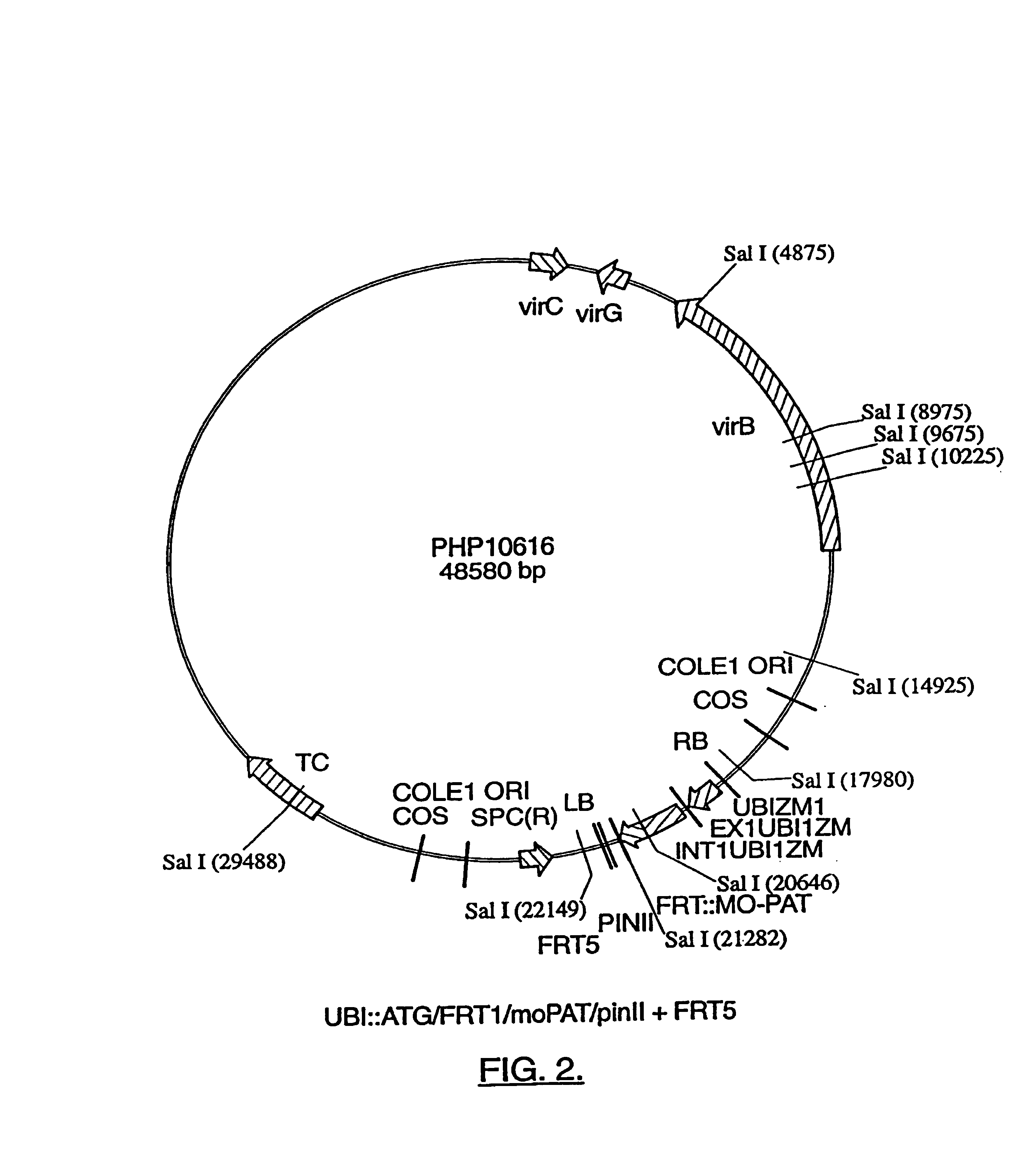Compositions and methods for the targeted insertion of a nucleotide sequence of interest into the genome of a plant
a nucleotide sequence and plant technology, applied in the field of plant genome insertion, can solve the problems of inability to precisely modify the structure of transgenes, and inability to randomly insert introduced dna into the genome of host cells
- Summary
- Abstract
- Description
- Claims
- Application Information
AI Technical Summary
Benefits of technology
Problems solved by technology
Method used
Image
Examples
example 1
Creation of Novel Non-identical FRT Sites
[0084]DNA fragments containing novel FRT sequences were constructed either by synthesizing, annealing and ligating complementary oligonucleotides or by creating primers for PCR amplification (Mullis and Faloona, 1987) of a DNA product containing the new FRT sequence near the 5′ end of the PCR product. The newly constructed FRT product includes flanking restriction sites useful for cloning into plant expression units. In general, the 5′ end is flanked by an NheI site and a terminal NcoI site. The NcoI site includes the bases ATG, which are advantageously used in newly developed vector constructs as the recognition sequence to initiate an open reading frame. In sequence-based constructs designated noATG / FRT, the NheI site is used for cloning thereby eliminating the upstream ATG in the process. At the 3′ end of the FRT sequence, a restriction site is included enabling unique identification of the individual spacer sequences. As specific examples...
example 2
Creation of Plant Transformation Vectors Containing Novel Non-identical FRT sites
[0087]Based on the design of FRT sites as described above, PCR or standard mutagenesis protocols were used to create an XhoI site overlapping the start of a gene sequence to be used for cloning downstream of the FRT site, thereby converting the ATG start codon to GTG. Ligation of an FRT to the mutated gene sequence at XhoI creates a new open reading frame initiating 5′ to the FRT. A second FRT sequence can be cloned downstream of the terminator using a variety of methods including PCR or ligation. The FRT / gene / terminator / FRT unit can then be used to make target or substrate constructs.
[0088]Targets are created by inserting a promoter at the NcoI site upstream of the first FRT. This maintains a complete open reading frame of the FRT / gene fusion. These target constructs are for use in transformation experiments to create desirable ‘target lines’. Substrate vectors are constructed by cloning with the NheI ...
example 3
Demonstration of Functionality of Novel FRT Sites and Requirement For Two Identical Sites for Efficient Recombination of DNA Sequences Positioned Between Two FRT Sites
[0089]Plasmids containing two identical or two different FRT sequences were assayed for efficiency of recombination of sequences between the FRT sites by transformation into 294-FLP, a version of the E. coli strain MM294 with FLP recombinase integrated into the lacZ locus (Buchholz et al. 1996). Strains were grown overnight at 37° C. with shaking, allowing for constitutive expression of FLP recombinase in the cultures. The plasmid DNA was isolated using standard procedures and digested with restriction enzymes that create novel restriction fragments following FLP mediated recombination. The extent of recombination between FRT sites was estimated by examining banding patterns on an agarose gel. Table 1 summarizes data from the gel analysis.
[0090]
TABLE 1Target Site CombinationExtent of RecombinationFRT1 and FRT1CompleteF...
PUM
| Property | Measurement | Unit |
|---|---|---|
| width | aaaaa | aaaaa |
| structure | aaaaa | aaaaa |
| Compositions | aaaaa | aaaaa |
Abstract
Description
Claims
Application Information
 Login to View More
Login to View More - R&D
- Intellectual Property
- Life Sciences
- Materials
- Tech Scout
- Unparalleled Data Quality
- Higher Quality Content
- 60% Fewer Hallucinations
Browse by: Latest US Patents, China's latest patents, Technical Efficacy Thesaurus, Application Domain, Technology Topic, Popular Technical Reports.
© 2025 PatSnap. All rights reserved.Legal|Privacy policy|Modern Slavery Act Transparency Statement|Sitemap|About US| Contact US: help@patsnap.com


